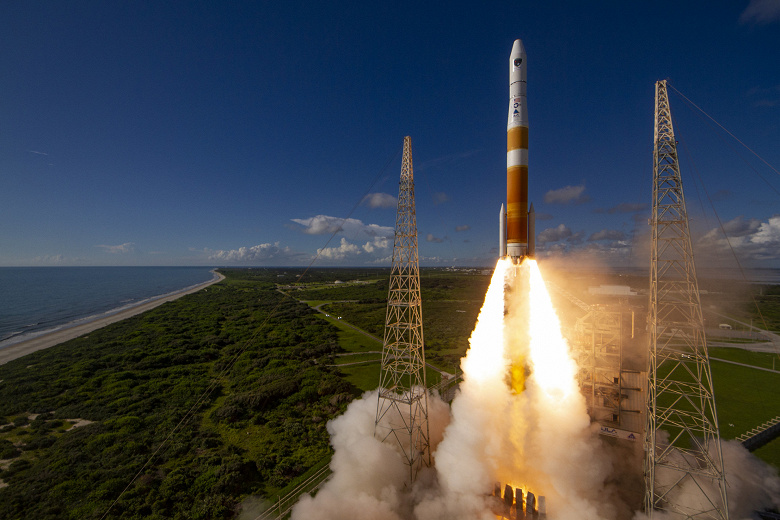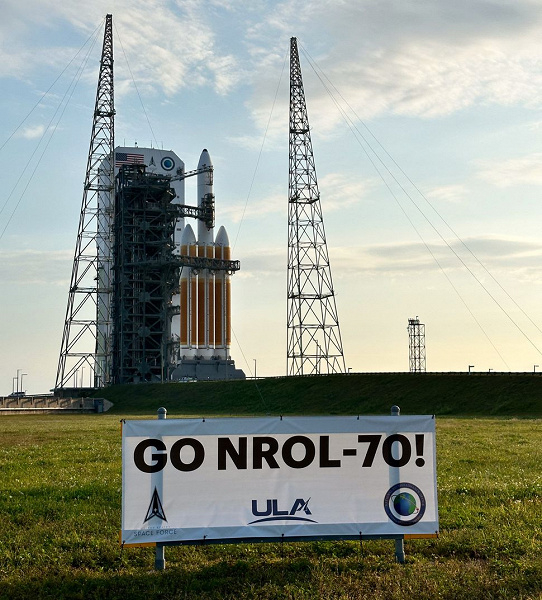64-year history of the Delta IV rocket ends with a mission for the US National Reconnaissance Office
The final launch of a United Launch Alliance (ULA) Delta rocket was scheduled to take place on March 29 on a mission for the US National Reconnaissance Office (NRO). The delayed launch will mark the end of 64 years of service for Delta, which was designed to carry large payloads into space. The Delta IV Heavy rocket, the 16th of its kind to fly since 2004, will carry classified cargo into space from Space Launch Complex 37 at Cape Canaveral Space Force Station in Florida.
ULA has not disclosed the nature of the payload, but it is believed that it could be a complex satellite for the US Department of Defense agency, which designs and operates surveillance satellites and rarely discloses the nature and purpose of its intelligence systems.
ULA management said the NROL-70 mission would only enhance the provision of timely intelligence to protect US interests and support humanitarian efforts around the world.
Until the very start, it remained unclear whether «Delta» will take off at the announced time because wind and clouds created unfavorable conditions. Because of the strong winds, there was a risk that the rocket would be blown back toward the launch tower, ULA President and CEO Tory Bruno said during a press conference: «if the winds subside, even for a few minutes, we will take advantage of that opportunity& raquo;.
As a result, the launch of Delta IV Heavy was postponed until April 1. United Launch Alliance said in a statement that the team continues to troubleshoot the nitrogen gas pipeline.
The rocket was designed as a modular system capable of launching in a variety of configurations depending on mission requirements, all configurations based on a common booster core (CBC) that forms the first stage of the rocket. The smallest configuration, Delta IV Medium, consisted of a CBC and a four-meter diameter version of the Delta cryogenic second stage (DCSS). The most powerful version — Delta IV Heavy — using three boosters and a five-meter second stage, is capable of launches that require high payload.
Intermediate configurations Medium+(4,2), (5,2) and (5,4) were used for loads too heavy for Medium, but not requiring Heavy characteristics. The two numbers at the end of their designation indicated the diameter of the upper stage (four or five meters) and the number of GEM-60 solid rocket engines to provide additional thrust in the early stages (two or four).
Delta IV Medium last flew in 2006 and was used for only three launches. In 2015, ULA announced plans to phase out the remaining members of the Delta IV family as the company began ramping up development of its next-generation Vulcan rocket. The Delta IV Heavy was to remain in service until the Air Force was satisfied that there was another missile capable of performing the same mission. Delta IV Medium+ made its last flight on August 22, 2019 with a GPS satellite.
Most of the Delta IV rocket's missions were for US military customers such as the Space Force (formerly the Air Force) and the NRO. There was only one launch for a commercial mission, which was the Eutelsat W5 satellite. Several early launches were under commercial contracts but with government payloads. For example, several GOES weather satellites have been launched for the National Oceanic and Atmospheric Administration (NOAA). In addition, Delta IV Heavy has completed two important missions for NASA, including the EFT-1 exploration launches in 2014 to test the Orion capsule. and the launch of the solar probe «Parker» in 2018 to study the Sun.
Delta IV also launched reconnaissance satellites such as the KH-11 Crystal, the Topaz radar imaging satellite, the Quasar communications satellite, and the KH-11 Crystal. and the ELINT elliptical orbit satellite for NRO. Most NRO satellites are classified, but some have come to light through declassified or leaked documents. The ELINT elliptical orbit satellites do not have a common name, but are considered successors to the earlier Trumpet program.

Monday's launch will be the 16th flight of Delta IV Heavy, surpassing the Medium+ configuration( 4.2) and will become the most popular Delta IV configuration. The Delta IV has successfully completed 43 of its 44 launches, with the only blemish on its record being its maiden flight of the heavy configuration (and the type's fourth launch overall) in December 2004. The launch was supposed to take place to place the spacecraft into a near-geosynchronous orbit, deploying two small satellites along the way. Cavitation — the formation of small bubbles or voids due to pressure drop — occurred in the oxidizer supply lines in all three CBCs. This caused the shutdown sensors to incorrectly determine that the oxidizer supply was depleted, causing all three boosters to shut down prematurely and resulting in the rocket entering a lower orbit than planned.
The launch on April 1 will take place from Cosmodrome 37B (SLC-37B) at the Space Force Station at Cape Canaveral. The site was built for launches of the Saturn 1 rocket. in the 1960s, including for the launch of the Apollo program. It was used for six launches of «Saturn 1» and two launches of Saturn-1B. The first launch was SA-5 — the first orbital launch of Saturn 1, and the last launch of Saturn 1 from the site was the Apollo 5 mission, in which an unmanned test of the lunar module was carried out in low Earth orbit.
Delta IV Heavy — It is a fully cryogenic rocket, its engines burning liquid hydrogen and liquid oxygen as fuel and oxidizer, respectively. This fuel will be loaded into the first and second stages as the countdown begins on Monday.
Delta IV — not the only rocket whose career is coming to an end. ULA also plans to phase out the Atlas V rocket and replace it with the new Vulcan Centaur rocket. The rocket's first mission was to launch the Peregrine lunar lander in early January. Despite the successful launch, the space module almost immediately suffered a fuel leak, aborting the mission.

